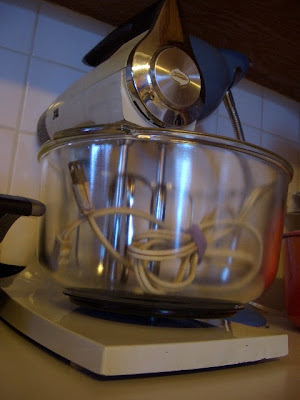The cake wasn’t terrible, though, and looks kind of charming in that fallen, flat, brownie kind of way:
But I come not to bring you cake, but capers. And cucumbers (for more cute recipes starting with the letter “c” and the rest of the alphabet, see Gourmet’s Sesame Street-esque September issue) – not combined together, but as two new starring roles in my usual roster of recipes (God. Can’t get enough alliteration. I promise to stop – now).
I first tossed capers into a batch of pesto a couple of weeks ago on a whim. I had been craving a tapenade, but having neither olives nor anchovies, yet copious amounts of backyard basil, I made what I thought was a compromise. A bit shy at first, I added only a few, careful not to disturb the careful balance of basil and olive oil. Struck, however, by the capers’ miraculous ability to blend right in to the emulsion, I added a few more and then a few more until I achieved that perfect hint of briny umami underneath the spicy and sharp overtones.
So. Good.
Yesterday I was again faced with too much basil – lemon basil this time – and again pulled out the Cuisinart. This time I skipped the garlic and the parmesan, and subbed walnuts for pinenuts, creating more of a pistou than a pesto, but once again added the requisite capers. This time the caper flavor shone through more fully without the competition of raw garlic and cheese, which, when tossed with raw baby squash, paired perfectly with frenchified white beans (I prepared them as I would have cooked puy lentils, with carrots and shallots) and a filet of Coho salmon (beautiful, wild caught, on sale, from New Seasons).
On the side I enjoyed the newest version of watermelon salad – with cucumber. I suppose I stole the idea from the aforementioned issue of Gourmet; however, they suggest serving the melon Greek-style with tzatziki sauce. The yogurt sounded weird, and a bit too filling to fit the rest of my meal, but the cucumber?
I have already spoke of my new respect for the vegetable in a certain beet and avocado salad crafted by a certain “Waters woman,” and I have since been looking for other new ways in which to use its crunch. Watermelon seemed the perfect match. Both are crisp, refreshing, subtle, and both pair perfectly with mint and lime (oh cucumber Ricky,* I love you so).
I chopped and de-seeded half of my yellow watermelon (yes, mom, it had real seeds – gotta love farmers’ markets!) and added de-seeded and thinly sliced cucumber (from about a two-inch chunk), about ¼ cup mint leaves in a chiffonade, and the juice of half a lime. Crunchy, cool, and with a bit of an acidic tang from the lime, this is the perfect fruit salad to eat every day for the rest of the summer – or at least until the melons are no longer ripe. Come to think of it, this combination would probably work with any ripe melon you can find, or even a mixture. Go wild!
*For my new favorite summer cocktail, muddle a couple slices of lime and a couple slices of cucumber with a couple mint leaves. Add ice and 1½-2 ounces of Plymouth or Aviation gin. Shake and pour into a highball glass. Top with soda. Sip. Sigh.




















